Regular Public Tours
General Addmissions: $1
Member Addmissions: FREE
Season: see Event Calendar if scheduled
Days/Hours: see Event Calendar if scheduled
Private Tours
General Addmissions: $1 per person (minimum charge of $10)
Member Addmissions: FREE
Season: all year
Days/Hours: request a tour time
Address: 225 East Cherry St., Canal Fulton, OH 44614
The Oberlin House Museum
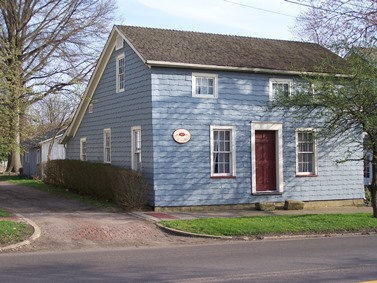
Built in 1847, this typical frame-house, with two rooms downstairs and two upstairs, was modified into the popular Colonial Salt Box style.1 It stands today as a vignette of how variuos canal-era families lived. The house, named in honor of one of the several families who resided here, is furnished in an 1800's style. Frequently, a costumed tour guide leads visitors through the property.
Mr. and Mrs. Tromp
In the mid-1800's, Canal Fulton was an attractive little place to settle; opportunities brought by the Ohio & Erie Canal would shape the course of history for the community. Business was booming along the Ohio & Erie Canal which in turn created economic opportunities in this former frontier village. Immigrants and migrants alike began arriving to take advantage of not just the situations available to canal boatmen and merchants, but also all of the other various jobs needed to support a growing community. Whether newly-arrived from the "old country" [i.e. Europe] or just relocating from a crowded family homestead in the colonial states, out here in the country a young family had space to grow. Indeed, the young Canal Fulton attracted all kinds.
Immigrating from Germany, William Tromp heeded the attraction to this new world bringing with him the skills he learned from his furniture-making family. On the advice of his brother about the growing prospects available out west, William and his wife Elizabeth (the couple having met in New York where they then lived for a time with William's brother) strode out here with their young family in tow. Here they could carve out a life for themselves in this bustling little in-land port. Calling this cozy house their home, William would put his skills to use by offering his services to the town through the 1870's.2
The Oberlin Family Tree
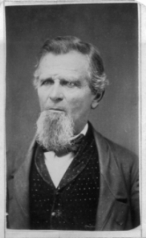
Born in what would become the greater Canal Fulton area, Joseph Oberlin entered this world in 1813. Throughout his early married life he, like most others in the surrounding countryside, was a farmer.3 His family, who hailed from Lancaster County, Pennsylvania, were among that pioneering generation who had forged through virgin wilderness via ox-drawn covered wagon, warily crossed mountain trails and subsisted on frontier hunting and gathering. They survived through their "determination to make their wishes materialize and supported by a strong faith in the God of our fathers."
Joseph and his wife Sarah, as was not uncommon in that day, would know both hope and heart-ache. Sadly, four of thier children would die in infancy; however, they would also know the joy of watching five of their children grow to adulthood. Their eldest child, Christian, born on the family farm on Dec. 24, 1841, would live to become one of Canal Fulton's prominent citizens.4
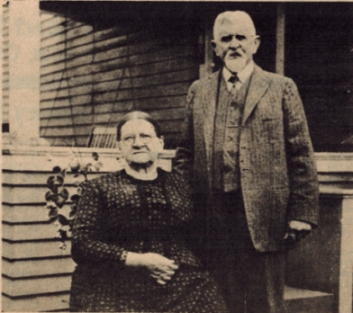
As a young man, Christian would serve the Union during the conflagration with the Confederate States, though national events did not tie up all of his time and on Oct. 22, 1863, he married Sarah Hartong.5 She herself was born in Lancaster, PA and at the age of 6 moved with her parents and surviving siblings to Canal Fulton.6 For a while, Christian would take over his family's farm but the couple would eventually sell it and move into town. By the late 1800's, they would reside in Tromp's two-story frame-house.7
Christian would work for a time as a painter and wallpaper hanger, eventually working with C.R. Daily's undertaking business.8 The home owners' carpentry skills would also be put to good use when he added an additional two rooms to the back of the house; thereby, converting it into the "salt box" style, which had been a popular trend on such houses since the colonial period.9 No doubt, Christian and Sarah were ensuring they would have all the space needed for a growing family - as indeed the couple was blessed with four daughters. No doubt the garden (which their daughters and even grandaughters would remember working in) kept in the back yard and all the canning they did from it helped the family's resources from being spread too thin.10
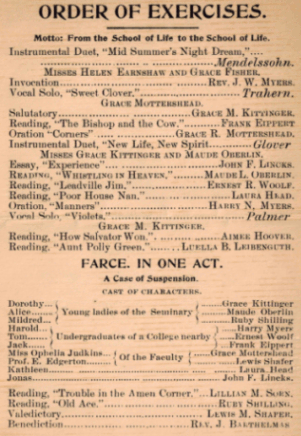
Christian would work and live a long full life before
retiring, all the while watching his daughters grow
to woman-hood and marry.
Their youngest, Maude, was born in 1886 - the same year Canal
Fulton's new school was opened directly across the street
from the home.11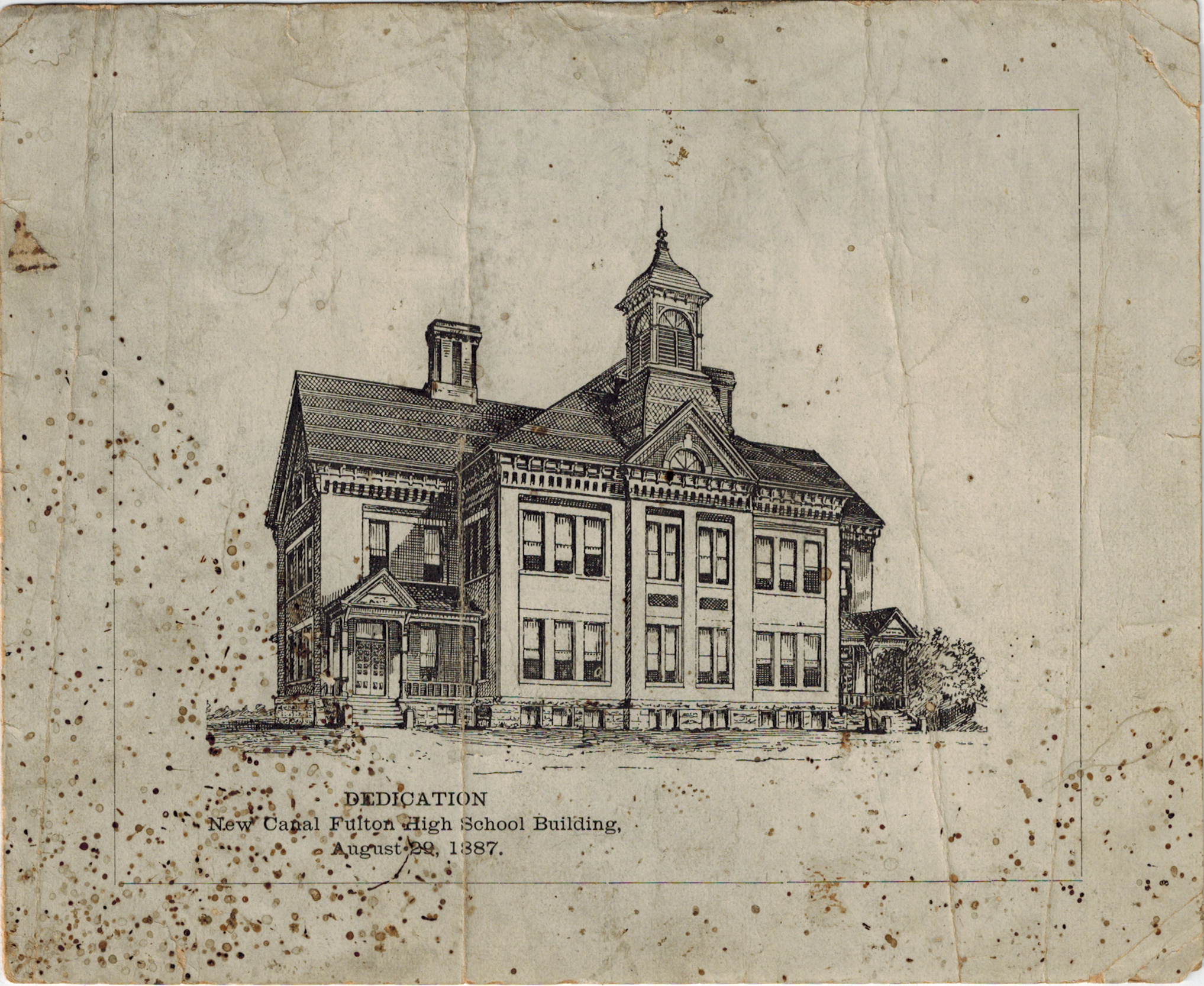 She would graduate from this same
school in 1904 and would soon after
marry Warren Burgert12
- the ceremony and reception all being held right there
in the family home.
She would graduate from this same
school in 1904 and would soon after
marry Warren Burgert12
- the ceremony and reception all being held right there
in the family home.
In 1907, Maude and Warren would give birth to their own daughter, Gladys (born in this vary home - the property at this time was owned by Frances - Maude's elder sister).13
The Oberlin Family Legacy
In the years to come, Gladys (Burgert) Mitchell, would come to hold very fond memories of the house where she was born and where her family had lived. However, Gladys wanted to not just preserve her ancestors' stories but also share them with the town. It became her goal to not only honor her parents and grandparents but indeed spur on the whole Canal Fulton community to work toward preservating its own history. Thus in 1972, she and her husband bought the property so they could donate it to the Heritage Society as a museum.14 Generous town residents responded in turn by donating time-appropriate furnishings to the Society and soon the house was dressed up in the style of an 1800's working-class family.


This whole project was an impressive undertaking for the young Heritage Society but, with hard work and the generosity of the community, it paid off.
What Old Architecture Can Teach Us
This style of frame-house became popular in the New
England colonies during the 1600's. As English
immigrants who had settled in the colonial states
continued spreading westward, this style home
followed. It increased in popularity because a simple
extension of the roof line down to the first floor
 allowed a further addition onto the house, making it
easy and affordable to accommodate a growing family.
Such an addition resembled the look of the boxes where
salt was stored in the kitchens of early American
homes during the colonial period; thus arose the
"Colonial Salt Box" style home.15
allowed a further addition onto the house, making it
easy and affordable to accommodate a growing family.
Such an addition resembled the look of the boxes where
salt was stored in the kitchens of early American
homes during the colonial period; thus arose the
"Colonial Salt Box" style home.15
Building designs are one of the wonderful tools that historians can use to help interpret the events of the past. Architectural styles can indicate anything from an owner's personal preferences to even popular social ideologies of the day. For example, within the 1700 to 1800's, the revival of Greek style buildings appealed on a philisophical level to the democratic sensibilities of these former colonial subjects.16 Canal Fulton has many examples of this popular Greek Revival style.*
Old architecture also reveals available types of building
technologies and techniques. Take for instance the
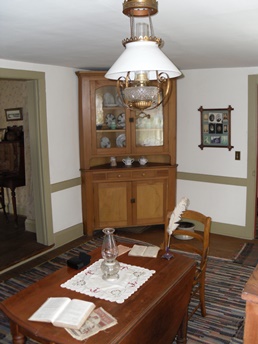 steep slope of a roof, evident on many of Canal
Fulton's earliest houses. This slope was standard in
early European designs in order to allow
water to readily drain from the semi-permeable
thatching used as roofing material.17
As building construction technologies
advanced and materials improved, roof slopes were
able to become much more shallow.18
Compare one of the
many Italianate style houses you can see around Canal
Fulton from the late 1800's to any of the various
frame-houses that had been popular prior to this.19
steep slope of a roof, evident on many of Canal
Fulton's earliest houses. This slope was standard in
early European designs in order to allow
water to readily drain from the semi-permeable
thatching used as roofing material.17
As building construction technologies
advanced and materials improved, roof slopes were
able to become much more shallow.18
Compare one of the
many Italianate style houses you can see around Canal
Fulton from the late 1800's to any of the various
frame-houses that had been popular prior to this.19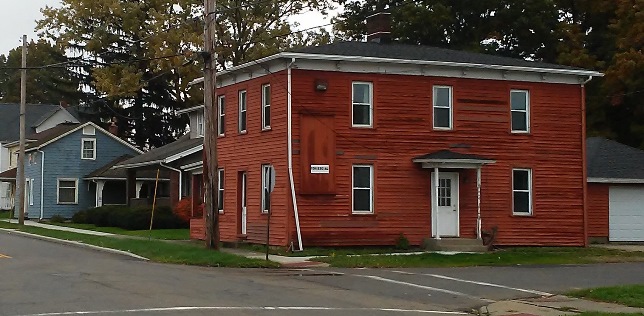 In a way, each new generation of architect, having
improved materials and methods, is saying to its
predecessors, "Look at what I can do..."
In a way, each new generation of architect, having
improved materials and methods, is saying to its
predecessors, "Look at what I can do..."

The frame-style of the Oberlin house reveals it was built for the simple utility of providing a home for a modest working class family. Contrast this with the more regal Victorian style of the William Blank House.20
Canal Fulton, like many old towns, shows a fascinating mixture of building styles, indicating the variety of architectural changes the town has seen throughout the years.
The Oberlin House Today
This home continues to model the lifestyle lived by early Canal Fulton residents. It is a look back at a simpler time era - a reminder of both the hardships and accomplishments of our ancestors. The house also stands as a sign of the commitment a daughter had for the memory of her parents' and grandparents' stories. In sum, it represents the dedication that this community has shown to preserving a piece of its own past.
Web Page Notes
1. The McAlester's outline basic houseing styles and plans that redily help one distinguish between various types of architectural forms.
Virginia and Lee McAlester A Field Guide to American Houses, (New York: Alfred A. Knopf, Inc., 1984), 23, 25, 27.
A "saltbox" type addition was popular on various forms of houses throughout the 1600-1800's.
Lester Walker American Houses: The Landmark Illustrated Encyclopedia of Domestic Architecture, (New York: Black Dog & Leventhal Publishers, 2014), 44-46, 77-78, 54, 66.
2. Following William's death in 1874, several of thier sons would keep the family business going.
Perrin, History of Stark Cty., 702.
3. Though he also dabbled in comercial and mechanical pursuits.
Joseph Oberlin obituary, Goshen (Indiana) Daily News-Times, 30 March 1903.
4. At least as of his death in July, 1929 when he was 88 yrs old he was also the town's oldest citizen.
"Canal Fulton's Oldest Citizen Died July 10, Aged 88 Years" ??? (Canal Fulton), 25 July 1929, partial photocopied article in CFHS collections.
"Canal Fulton's Oldest Citizen."
Frances Harting obituary, ??? (Canal Fulton), 27 February, 1902, partial photocopied article in CFHS collections.
Streby, Nostalgia, 50.
"Canal Fulton's Oldest Citizen."
...footnote and reference forth coming...
Email from Beverly Wallace, Gladys Burgert Mitchell's daughter, relating notes from her mother, 17 July 2016, CFHS records.
In those days people of humble means only went to the local grocer for food itmes they couldn't grow themselves. Eating fresh garden produce and home canning in preperation for winter were a way of life.
11. This school would hold countless memories for not just Maude but all its graduates. ...
...further notes and reference forth coming...
12. Warren's father, Joseph, also a veteran of the Civil War found tremendous success working as a coal prospector/driller in the Canal Fulton area. Joseph later traded in his coal career and lived out his days on a comfortably-sized farm which he worked with his sons.
Streby, Nostalgia, 48.
"Mr. and Mrs. Joseph W. Burgert," ?Canton? News, 19 April 1928, partial photocopied article in CFHS collections.
13. The property would continue to change hands at various times through the years. Maude and Warren themselves owning it from 1931 to 1936. The last Oberlin to have resided on the property was their niece, Grace, in 1941.
Grace Tilton Curtiss obituary, deceased on Nov 18, 1985 (San Clemente California), partial photocopied article in CFHS collections.
In Gladys' passion for family history she compiled the above referenced obituaries, news articles, military records and of course stories and photos - all of which she entrusted to our Society to utilize in helping to tell the story of the Oberlin [and extended] family.
We hope the brief spotlight we have herein shed does justice to her wishes.
14. In a correspondance letter wherein she presented her gift to the Society, Gladys says:
"Mr. Mitchell and I were raised in Canal Fulton and we have always had an interest in the progress of the town. My grandparents Christopher and Sarah Oberlin lived in an old house on Cherry Street in the village and my parents were married in this home and I was born there. It has always been my desire to own the house and since it was available this year for purchase I have completed the transaction. Now it gives me great pleasure to present your society with the deed for the property, hoping this gift will stimulate the people to promote and develop a historically attractive town."
Gladys Burgert Mitchell letter to Canal Fulton Heritage Society, 16 December 1972, CFHS records.
Warranty Deed, Gladys Burgert Mitchell to Canal Fulton Heritage Society, 22 December 1972, CFHS records.
15. [I wanted to insert here a picture of an actual colonial era salt box. Anyone out there in cyberspace happen to know where we could reasonably get our hands on a real colonial salt box (so we can display it in the Oberlin House kitchen, use it as a reference/teaching tool, etc.)? My little sketch above the animated carpenter was intended just as a place holder until we got the real thing. ~ Website Editor]
16. As one of the difference in form beteeen the basic I-house [aka frame house] and the more ornate Greek Revival is the orientation of the gable it is also possible that part of the latters' popularity was that it afforded the simplicity of the I-house style but was situated longwise to better accomodate city lots.
McAlester, American Houses, 90, 177ff.
Walker, American Homes, 108.
McAlester, American Houses, 8, 28.
McAlester, American Houses, 106.
19. Note how the slope of the roof on the Oberlin House [blue house in background - built 1847] is steeper than the red house in the foreground [Italianate style - built in the 1860's].

J K Stringer, Stark County Regional Planing Commission, Ohio Historic Inventory - survey of historic buildings within Canal Fulton's Historic District, September 1980, CFHS Records.
This house in the foreground of the photo was apparently used for a time as Mr. Tromp's workshop.
Website Editors's conversations with great, great grandnephew of William Tromp, July 2013.
The same was also residence for Tromp's family in the late 1800's.
W. S. Hostetler, Directory of Canal Fulton, Stark County, Ohio, December 1896, (Canal Fulton: Signal Print, 1896) ???page???.
Streby, Nostalgia, ???page???.
20.
When access to standardized dimensional lumber became
readily available the large hand-hewn post and girts
techniques - which formerly constrained building shapes
to long rigid walls at 90 degree angles - were replaced
by other methods like Balloon Framing which allowed much
more freedom of form for the building architect in this
later part of the 1800's. This new freedom gave
architects greater ability
to more easily incorporate a variety of shapes into
building designs.*
McAlester, American Houses, 34ff, 239.


